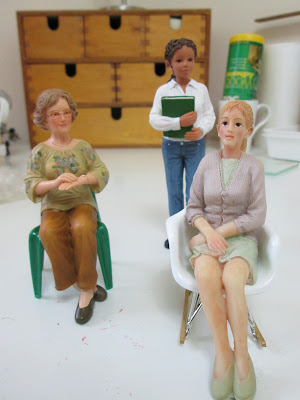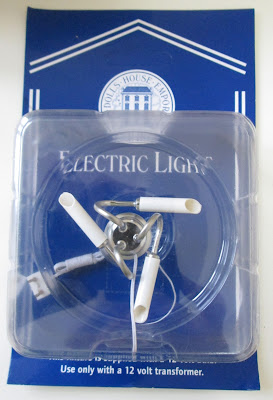Not all ceiling lights will just be in the centre of a room. You might want a hanging light over a dining table for example. The first step must be taking time to be absolutely sure you know what you want where.
One way to help you position the lights is to draw an accurate floor (ceiling) plan to scale and plot out where the light should go in relationship to your needs (furniture etc). I have seen a ton of low hanging chandeliers that no human could walk under in many dolls houses, maybe you want to avoid that in some way. If your Georgian house doesn't give you a ten inch or more ceiling height then your powdered wigs would very quickly catch fire when moving around the grand salon. Equally candles can not be too near the ceiling or the walls for the same reason. My sitting room, for example, won't have a single hanging light as it is only an eight foot high room. Deduct three feet for very small chandeliers - the grander they are the lower they hang - and I am only left with a five foot walk space beneath. Clearly daft if you are aiming for any kind of realism. Like many real Georgian rooms it will rely on wall sconces and candles on stands and candelabras on tables even if they are now electric!
If you need to see your room in 3D rather than in plan form and have the furniture already - put it in place and think about where your light should go. Failing that make a really rough mock up to give you some sense of what's needed.
 |
| utility room |
My utility room needs a light over the 'work area' but not too near any wall cupboards. My plan of putting the lights in the basement area to enable me to get up to start the second floor may be delayed again as it would be better to get the cupboards in and the floor and ceilings trimmed in this room without a light in the way when I am working. Curses - I hadn't thought of that. Quite literally it is back to the drawing board for me to draw up plans for the utility room and then order up the flat pack kits from ELF.
 |
| test wire |
It is useful if you have some spare wire to test in the grooves as you make them so you don't maul your actual lights around too much. I have a roll of it but any little snip will do as long as you test it down the full length of the groove to make sure it lies in there nicely.
Ironically the other thing that is handy is some sort of light in the space that you want to light! It is decidedly dark in most dolls house rooms. Here I am using one of those lights you wear on your forehead when working in such restricted spaces but it is more useful just plonked on the floor of the room than on my head which doesn't actually go inside the room when I am working there. An ordinary torch works just as well.
These two photos show two different ways of going about the job of making a groove.
 |
| manual method |
After drilling the hole for the light and the wire exit hole I used a steel rule and box knife to cut two slits, close together from one hole to the other. I then gouged out the wood in between with the file. Easy peasy. It took a matter of a couple of minutes and gave me a nice straight line and tidy groove.
 |
| power tool method |
Here I used a steel rule, box knife and Rotary tool. Ended up with a wobbly groove which even had differing depths and it took longer than the manual method.
Seems like a no-brainer to me which method to choose. I cut my third groove (and all that will follow) by hand. Forget investing on a rotary tool for the job like I did unless you are a tool fanatic.... they do exist.
However, I would recommend a power tool for the drilling part of this exercise. It is in no way essential but it was so easy with a right-angle power drill. You can get an attachment for any power drill I think if you don't want to buy a separate right-angled drill. That said, mine came from the internet cheaply and is battery powered so gives me easy access. Hand drilling takes a degree of muscle power or it takes forever. Slight pressure on the head of this drill, over the bit, and it took a couple of seconds. Six holes done seemingly instantly. Works nice and vertically in the centre of the room (for the light fitting) and works fine at an angle at the back of the room (for exit holes).


















